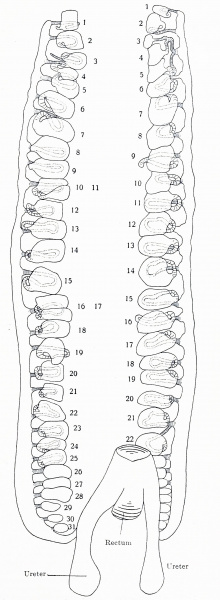File:Keibel Mall 2 565.jpg

Original file (1,000 × 2,727 pixels, file size: 370 KB, MIME type: image/jpeg)
Fig. 565. Model of the mesonephroi, the metanephroi and the bladder of a human embryo of 7 mm greatest length
(Embryo Chr. 1, from the collection of Professor Hochstetter, Vienna. The model has been prepared by my students A. Wachter and E. vonWyss.) View from in front. 75.
The mesonephroi have a perpendicular position and the individual tubules are at sufficient distances, so that the Malpighian corpuscles lie in a single row. The lowest tubules are still developing, but have already united with the excretory duct (Fig. 561 e). The fully developed canals are S-shaped. Most ventrally are the Malpighian corpuscles, then in the middle is the secreting tubule and most dorsally the collecting tubule. The loop formed by the secreting and collecting tubules usually has not yet reached the medial border of Bowman's capsule. The whole coil of a mesonephric segment (Malpighian corpuscle and the two tubules) lies still in one horizontal plane. The primary excretory duct is narrow in its upper part and only widened in a spindle-shaped manner corresponding to the entrance into it of a collecting tubule; in its lower portion it is remarkably wide and the spindle-like enlargements have disappeared. Towards the bladder the duct narrows again. The ureters are short and almost straight canals terminating in club-shaped enlargements.
| Embryology - 26 Apr 2024 |
|---|
| Google Translate - select your language from the list shown below (this will open a new external page) |
|
العربية | català | 中文 | 中國傳統的 | français | Deutsche | עִברִית | हिंदी | bahasa Indonesia | italiano | 日本語 | 한국어 | မြန်မာ | Pilipino | Polskie | português | ਪੰਜਾਬੀ ਦੇ | Română | русский | Español | Swahili | Svensk | ไทย | Türkçe | اردو | ייִדיש | Tiếng Việt These external translations are automated and may not be accurate. (More? About Translations) |
Felix W. The development of the urinogenital organs. In Keibel F. and Mall FP. Manual of Human Embryology II. (1912) J. B. Lippincott Company, Philadelphia. pp 752-979.
| Historic Disclaimer - information about historic embryology pages |
|---|
| Pages where the terms "Historic" (textbooks, papers, people, recommendations) appear on this site, and sections within pages where this disclaimer appears, indicate that the content and scientific understanding are specific to the time of publication. This means that while some scientific descriptions are still accurate, the terminology and interpretation of the developmental mechanisms reflect the understanding at the time of original publication and those of the preceding periods, these terms, interpretations and recommendations may not reflect our current scientific understanding. (More? Embryology History | Historic Embryology Papers) |
Cite this page: Hill, M.A. (2024, April 26) Embryology Keibel Mall 2 565.jpg. Retrieved from https://embryology.med.unsw.edu.au/embryology/index.php/File:Keibel_Mall_2_565.jpg
- © Dr Mark Hill 2024, UNSW Embryology ISBN: 978 0 7334 2609 4 - UNSW CRICOS Provider Code No. 00098G
File history
Click on a date/time to view the file as it appeared at that time.
| Date/Time | Thumbnail | Dimensions | User | Comment | |
|---|---|---|---|---|---|
| current | 07:47, 16 November 2018 | 1,000 × 2,727 (370 KB) | Z8600021 (talk | contribs) | ||
| 07:46, 16 November 2018 |  | 2,046 × 3,282 (953 KB) | Z8600021 (talk | contribs) |
You cannot overwrite this file.
File usage
The following 2 pages use this file:
